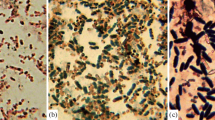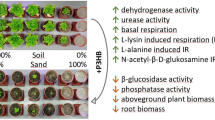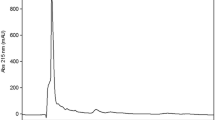Abstract
Changes in the number of bacteria and relative distribution of strains producing poly-3-hydroxybutyrate (PHB) in soil were investigated. Samples of chernozem soil were cul tivated with glucose in the presence of a mineral nitrogen source (diammonium hydrogen phos phate) or in its absence, either in a batch or a heterocontinuous cultivation system. In both cultivation systems the addition of glucose resulted in a roughly ten-fold increase of bacteria concentration and an increase in the proportion of strains able to produce PHB granules. When the nitrogen source was added simultaneously with glucose, the concentration of bacteria increased by two orders of magnitude in both cultivation systems. In the batch system changes in the concentration of strains capable of PHB production were very small under these con ditions whereas in the heterocontinuous system their number decreased by almost 50 %. The survival of bacteria in the soil suspension after 57-d starvation was associated with PHB production which differed, depending on the previous treatment of the soil samples. The concentration of bacteria decreased least pronouncedly in the control with water and most significantly during cultivation with glucose and a nitrogen source, where the initial PHB content was very low in spite of high numbers of bacteria.
Similar content being viewed by others
References
Boylen C.W., Mulks M.H.: Coryneform bacteria during periods of prolonged nutrient starvation.J.Gen.Microbiol.105, 323 (1978).
Breznak J.A., Potrikus C.J., Pfennig N., Ensign J.C.: Viability and endogenous substrates used during starvation survival ofRhodospirillum rubrum. J.Bacteriol.134, 381 (1978).
Dawes E.A.: Endogenous metabolism and the survival of starved prokaryotes.Symp.Soc.Gen.Microbial.26, 19 (1976).
Dawes E.A., Ribbons D.W.: Studies on the endogenous metabolism ofEscherichia coli. Biochem. J.95, 332 (1965).
Doudoroff M., Stanier R.Y.: Role of poly-β-hydroxybutyric acid in the assimilation of organic carbon by bacteria.Nature183, 1440 (1959).
Hanzlíková A., Jandera A., Kunc F.: Formation of poly-3-hydroxybutyrate by a soil microbial community during batch and heterocontinuous cultivation.Folia Microbiol.29,233 (1984).
Hattori T.:Microbial Life in the Soil. An Introduction (A.D. McLaren, Ed.). M. Dekker, New York 1973.
Kannan L.V., Řeháček Z.: Formation of poly-β-hydroxybutyrate by actinomycetes.Ind.J.Biochem.7, 126 (1970).
Kunc F., Macura J.: Decomposition of root exudates in soil.Folia Microbiol.11, 239 (1966).
Macijra J.: Heterocontinuous cultivation of microorganisms in soil. (In Czech)DSc Thesis, Institute of Microbiology, Czech.Acad.Sci., Prague 1969.
Macura J., Kunc F.: Continuous flow method in soil microbiology. V. Nitrification.Folia Microbiol.10, 125 (1965).
Matin A., Veldhuis C., STEGEMAN V., VEENHUIS M.: Selective advantage of aSpirillum species in a carbon limited environment. Accumulation of poly-β-hydroxybutyric acid and its role in starvation.J.Gen.Microbiol.112, 349 (1979).
Nikitin D.I., Nikitina E.S.:Self-cleaning Processes of Environment and Bacterial Parasites (Genus Bdellovibrio). (In Russian) Nauka, Moscow 1978.
Nuti M.P., Brooks J.B., Lepidi A.A.: Occurrence of α-, β-, and γ-hydroxybutyrates in some soil microfungi.Trans.Brit.Mycol.Soc.64, 79 (1975).
Nuti M.P.,Lepidi A.A.: Poly-β- hydroxybutyrates occurrence inSaccharomyces cerevisiae and its significance in the fermentation process, p. 123 inProc.Fourth Int.Syrnp. of Yeasts, Part I, Vienna 1974.
Schlegel H.G., LAFERTY R., Krauss I.: The isolation of mutants not accumulating poly-β-hydroxybutyric acid.Arch.Microbiol.71, 283 (1970).
Taylor C.B.: The nutritional requirements of predominant flora of the soil.Proc.Soc.Appl.Bact.14, 101 (1951).
Author information
Authors and Affiliations
Rights and permissions
About this article
Cite this article
Hanzlíková, A., Jandera, A. & Kunc, F. Poly-3-hydroxybutyratc production and changes of bacterial community in the soil. Folia Microbiol 30, 58–64 (1985). https://doi.org/10.1007/BF02922499
Received:
Issue Date:
DOI: https://doi.org/10.1007/BF02922499




